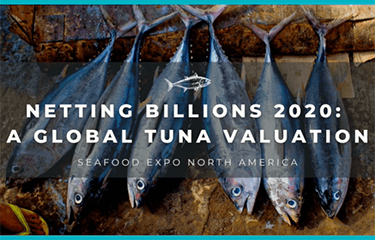The 2022 Seafood Expo North America, which took place 13 to 15, March in Boston, Massachusetts, U.S.A., and the 2022 Seafood Expo Global, 26 to 28 April, 2022, in Barcelona, Spain, featured a comprehensive conference program of live panel events focusing on topics chosen to be of vital interest to the seafood industry.
The 28 individual presentations from SENA and the 21 sessions from SEG featured exclusive information and insight from seafood industry experts, including economic forecasts and analysis on the trends and topics impacting the global seafood industry as it navigates issues of trade, food safety, traceability, aquaculture, sustainability, and consumption trends. Now, a video recording of each of these sessions is available for on-demand replay.
Featuring The Pew Charitable Trusts Senior Officer Grantly Galland, Ahold Delhaize Vice President of Product Integrity Hugo Byrnes, Marine Instruments Strategic Business Development Director Greg Hammann, Pew Charitable Trusts Senior Associate Raiana McKinney, and Global Tuna Alliance Executive DirectorTom Pickerell, “Netting Billions 2020: A Global Tuna Valuation” is available free for SeafoodSource Premium members, or for individual purchase to non-Premium members for USD 40. It was presented on Tuesday, 15 March, with the following description:
In 2018, commercial tuna fishing was worth more than USD 40 billion (EUR 37 million) to the world economy, more than the GDP of at least 100 nations. From canned tuna to top-shelf bluefin sashimi, these fisheries generate significant revenue and support an enormous industry from the fishers all the way to the consumers. Due to the ongoing global pandemic, demand for non-perishable protein sources, such as canned tuna, has skyrocketed. It is easy to see just how vital the tuna industry is for not just the blue economy—but for food security around the world.
But while vessels are catching more tuna than ever before to meet this demand, the value at the dock and at the final point of sale has decreased since 2012. When factoring in the costs associated with higher catch, profits may have even declined substantially. The message is clear: catching more fish is not always better for the bottom-line. Sustainably managing tuna fisheries and allowing overfished stocks to recover will maximize their value, reduce the cost of fishing, and sustain marine ecosystems and the industries and people who rely on tuna fishing. Better management of tuna fisheries is not simply a conservation issue but also an economic one.
Yet, more often than not, the long-term sustainability of these fisheries takes a back seat to the short-term political or monetary gains that often drive management decisions. Adopting forward thinking harvest strategies, coupled with stronger consequences for noncompliance and well-developed electronic monitoring of fishing activity would all help restore tunas to healthy population sizes, preserve their value, and ensure that these valuable fisheries are being governed effectively.
This session would start with an overview presentation on recent research to estimate the global monetary value of commercial tuna fisheries. Beyond the economics, the presentation will cover the tuna fisheries management process and discuss ways governments and industry can improve management of fish stocks globally by:
- Modernizing management through harvest strategies,
- Improving oversight and accurate reporting of fishing activities, and
- Ensuring consequences for noncompliance with fisheries rules.
The entire package of videos from SENA and the entire package of videos from SEG can each be purchased for USD 250, but all are free to SeafoodSource Premium members.







